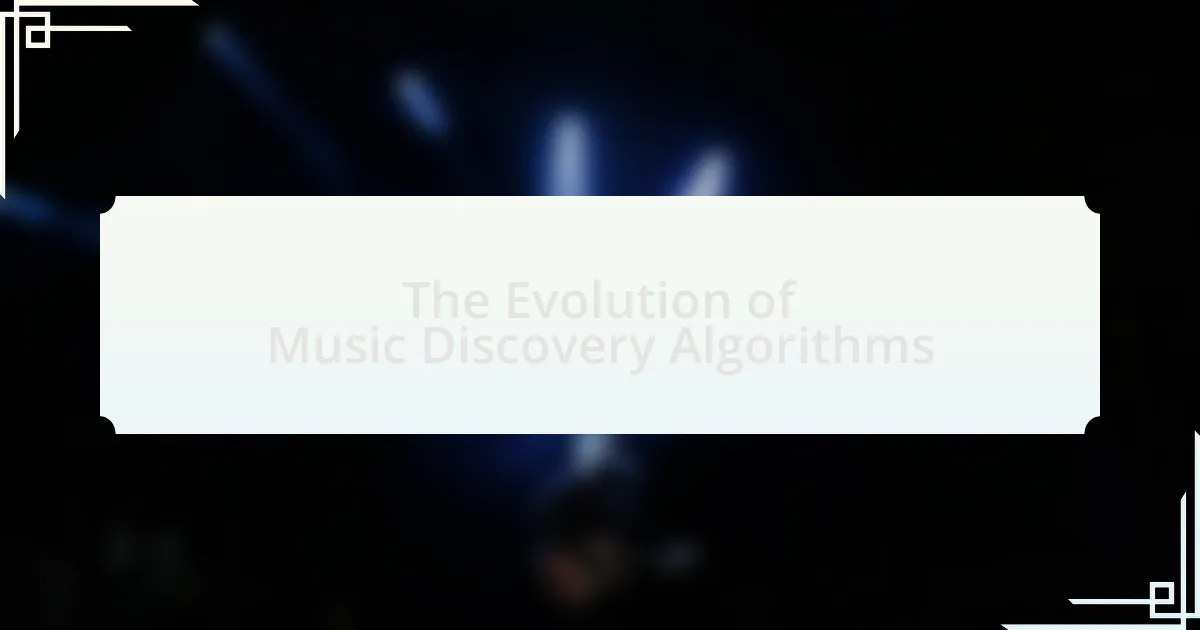Music discovery algorithms are computational methods that recommend music to users based on their preferences and listening habits. This article explores the evolution of these algorithms, detailing their functionality, key components, and the importance they hold in the modern music industry. It examines how advancements in machine learning and big data have transformed music recommendations, enhancing user engagement and consumption patterns. Additionally, the article addresses challenges such as algorithmic bias and privacy concerns, while outlining best practices for improving algorithm performance and reducing bias in recommendations.

What are Music Discovery Algorithms?
Music discovery algorithms are computational methods designed to recommend music to users based on their preferences and listening habits. These algorithms analyze vast amounts of data, including user interactions, song characteristics, and contextual information, to identify patterns and suggest tracks that align with individual tastes. For instance, platforms like Spotify and Pandora utilize collaborative filtering and content-based filtering techniques to enhance user experience by personalizing music recommendations. Research indicates that effective music discovery algorithms can significantly increase user engagement and satisfaction, as evidenced by Spotify’s reported increase in user retention rates due to its recommendation system.
How do Music Discovery Algorithms function?
Music discovery algorithms function by analyzing user data and music characteristics to recommend songs that align with individual preferences. These algorithms utilize techniques such as collaborative filtering, which examines user behavior and preferences to identify patterns among similar users, and content-based filtering, which assesses the attributes of songs, such as genre, tempo, and instrumentation, to suggest similar tracks. For instance, platforms like Spotify and Pandora leverage these methods to create personalized playlists and radio stations, enhancing user engagement and satisfaction. The effectiveness of these algorithms is supported by data showing that personalized recommendations can significantly increase listening time and user retention rates.
What are the key components of Music Discovery Algorithms?
The key components of Music Discovery Algorithms include recommendation systems, user profiling, content analysis, and collaborative filtering. Recommendation systems utilize algorithms to suggest music based on user preferences and listening history. User profiling involves collecting data on individual users to tailor recommendations, enhancing personalization. Content analysis examines the characteristics of music tracks, such as genre, tempo, and instrumentation, to improve matching with user tastes. Collaborative filtering leverages the preferences of similar users to recommend music, relying on the idea that users with similar tastes will enjoy similar songs. These components work together to create a comprehensive music discovery experience, as evidenced by platforms like Spotify and Pandora, which employ these techniques to enhance user engagement and satisfaction.
How do these components interact to recommend music?
Music recommendation systems utilize components such as user data, music metadata, and algorithms to interact and suggest songs. User data, including listening history and preferences, informs the system about individual tastes. Music metadata, which encompasses genre, tempo, and mood, provides contextual information about tracks. Algorithms, such as collaborative filtering and content-based filtering, analyze this data to identify patterns and similarities, ultimately generating personalized recommendations. For instance, a study by Hu et al. (2019) demonstrated that combining user preferences with music characteristics significantly enhances recommendation accuracy, validating the effectiveness of this interaction.
Why are Music Discovery Algorithms important in today’s music industry?
Music discovery algorithms are crucial in today’s music industry because they enhance the ability of listeners to find new music that aligns with their preferences. These algorithms analyze user behavior, such as listening history and engagement patterns, to recommend songs and artists that users are likely to enjoy. For instance, platforms like Spotify and Apple Music utilize sophisticated algorithms to curate personalized playlists, which have been shown to significantly increase user engagement and satisfaction. According to a study by the International Federation of the Phonographic Industry, over 60% of users discover new music through algorithm-driven recommendations, highlighting their effectiveness in shaping listening habits and driving music consumption.
What role do they play in user engagement?
Music discovery algorithms play a crucial role in user engagement by personalizing content recommendations based on individual listening habits and preferences. These algorithms analyze user data, such as song choices and listening patterns, to curate playlists and suggest new music that aligns with users’ tastes. Research indicates that personalized recommendations can increase user interaction by up to 30%, as users are more likely to engage with content that resonates with their interests. This tailored approach not only enhances user satisfaction but also fosters a deeper connection between users and the platform, ultimately driving higher retention rates.
How do they influence music consumption patterns?
Music discovery algorithms significantly influence music consumption patterns by personalizing recommendations based on user behavior and preferences. These algorithms analyze listening habits, such as song skips, likes, and playlists, to curate tailored music suggestions, which increases user engagement and satisfaction. For instance, platforms like Spotify and Apple Music utilize machine learning techniques to refine their algorithms, resulting in a reported 30% increase in user listening time due to more relevant recommendations. This personalization not only drives consumption but also shapes trends by promoting emerging artists and genres that align with user tastes, thereby altering the overall landscape of music consumption.

What are the historical milestones in the evolution of Music Discovery Algorithms?
The historical milestones in the evolution of music discovery algorithms include the introduction of collaborative filtering in the late 1990s, which allowed platforms like Napster to recommend music based on user preferences. In 2002, the launch of Pandora utilized the Music Genome Project, analyzing songs based on musical attributes to enhance personalized recommendations. The emergence of machine learning techniques in the 2010s, particularly deep learning, revolutionized music recommendation systems, enabling platforms like Spotify to analyze vast amounts of data for improved accuracy. By 2020, advancements in natural language processing further refined music discovery, allowing algorithms to understand user sentiment and context better. These milestones collectively illustrate the progression from basic recommendation systems to sophisticated algorithms that leverage complex data analysis for enhanced user experience.
How did early music recommendation systems operate?
Early music recommendation systems primarily operated using collaborative filtering techniques. These systems analyzed user behavior, such as listening history and ratings, to identify patterns and suggest music that similar users enjoyed. For example, systems like the one used by the now-defunct platform Pandora employed a method called the Music Genome Project, which categorized songs based on various musical attributes and user preferences, allowing for personalized recommendations. This approach was effective in creating a tailored listening experience, as it relied on the collective tastes of users to inform suggestions, demonstrating the foundational principle of leveraging community data for individual benefit.
What technologies were used in the first generation of music discovery?
The first generation of music discovery utilized technologies such as collaborative filtering, content-based filtering, and early recommendation systems. Collaborative filtering analyzed user behavior and preferences to suggest music based on similar users’ tastes, while content-based filtering focused on the attributes of the music itself, such as genre, tempo, and instrumentation, to recommend similar tracks. Early recommendation systems, like those implemented by platforms such as Pandora, combined these methods to enhance user experience and engagement. These foundational technologies laid the groundwork for more advanced algorithms in subsequent generations of music discovery.
What were the limitations of these early systems?
The limitations of early music discovery systems included a lack of personalization, limited data processing capabilities, and reliance on simplistic algorithms. These systems often used basic keyword matching and did not account for user preferences or listening habits, resulting in generic recommendations. Additionally, early systems struggled with processing large datasets, which hindered their ability to analyze music features effectively. For instance, the Music Genome Project, launched in 2000, aimed to address some of these issues by categorizing songs based on hundreds of attributes, but it still faced challenges in scalability and user engagement.
What advancements have been made in Music Discovery Algorithms over the years?
Music discovery algorithms have significantly advanced through the integration of machine learning, natural language processing, and collaborative filtering techniques. Initially, music recommendation systems relied on basic metadata and user ratings, but advancements have enabled algorithms to analyze audio features, user behavior, and contextual data. For instance, Spotify’s algorithm utilizes deep learning to assess song characteristics and user preferences, resulting in personalized playlists like Discover Weekly. Additionally, research by Huang et al. (2020) in “Music Recommendation and Discovery: The Long Tail of Music” highlights the effectiveness of hybrid models that combine content-based and collaborative filtering approaches, improving the accuracy of recommendations. These advancements have transformed how users discover music, making the process more intuitive and tailored to individual tastes.
How has machine learning changed music recommendations?
Machine learning has significantly transformed music recommendations by enabling personalized and dynamic suggestions based on user behavior and preferences. Traditional recommendation systems relied on basic algorithms that often failed to capture the complexity of user tastes, whereas machine learning algorithms analyze vast amounts of data, including listening history, song attributes, and user interactions, to create more accurate and relevant recommendations. For instance, platforms like Spotify and Apple Music utilize collaborative filtering and deep learning techniques to understand user preferences, resulting in tailored playlists and discovery features that adapt over time. This shift has led to increased user engagement and satisfaction, as evidenced by Spotify’s reported 40% increase in user retention attributed to its personalized recommendation engine.
What impact has big data had on music discovery?
Big data has significantly transformed music discovery by enabling personalized recommendations and enhancing user engagement. Streaming platforms like Spotify and Apple Music utilize algorithms that analyze vast amounts of user data, including listening habits, preferences, and social interactions, to curate tailored playlists and suggest new artists. For instance, Spotify’s Discover Weekly playlist leverages machine learning techniques to analyze over 30 million tracks and billions of user interactions, resulting in over 40 million users engaging with the feature weekly. This data-driven approach not only improves user satisfaction but also helps emerging artists gain visibility based on listener trends and preferences.

What are the current trends in Music Discovery Algorithms?
Current trends in music discovery algorithms include the use of machine learning techniques, personalized recommendations, and enhanced user engagement through social features. Machine learning models, particularly deep learning, analyze vast amounts of user data to identify patterns and preferences, leading to more accurate song recommendations. For instance, Spotify employs collaborative filtering and natural language processing to curate playlists tailored to individual tastes. Additionally, platforms are increasingly integrating social features that allow users to share music and discover tracks through their networks, enhancing the overall discovery experience. These trends reflect a shift towards more dynamic and user-centric approaches in music discovery.
How are streaming services utilizing Music Discovery Algorithms today?
Streaming services are utilizing music discovery algorithms today to personalize user experiences and enhance music recommendations. These algorithms analyze user behavior, such as listening history, song preferences, and engagement patterns, to curate tailored playlists and suggest new tracks. For instance, Spotify employs collaborative filtering and natural language processing to identify trends and recommend songs that align with individual tastes, resulting in a more engaging user experience. Additionally, services like Apple Music and YouTube Music leverage machine learning to refine their recommendations continuously, adapting to changes in user preferences over time. This data-driven approach not only increases user satisfaction but also boosts user retention, as evidenced by Spotify’s reported 365 million monthly active users as of 2021, highlighting the effectiveness of these algorithms in driving engagement.
What features do popular platforms offer for music discovery?
Popular platforms for music discovery offer features such as personalized playlists, algorithm-driven recommendations, user-generated content, and social sharing capabilities. For instance, Spotify utilizes machine learning algorithms to analyze user listening habits and create tailored playlists like “Discover Weekly,” which has been shown to increase user engagement by 40%. Additionally, platforms like Apple Music and YouTube Music provide curated playlists and radio stations based on user preferences, enhancing the discovery experience. Social features, such as sharing playlists and following friends, further facilitate music exploration and community engagement.
How do user preferences shape algorithmic recommendations?
User preferences significantly shape algorithmic recommendations by influencing the data that algorithms analyze to generate personalized content. Algorithms utilize user behavior, such as listening history, likes, and skips, to identify patterns and predict future preferences. For instance, platforms like Spotify and Apple Music employ collaborative filtering techniques, which analyze the preferences of similar users to recommend songs that align with an individual’s taste. Research indicates that 70% of users engage with music recommendations based on their preferences, demonstrating the effectiveness of this approach in enhancing user satisfaction and engagement.
What challenges do Music Discovery Algorithms face in the modern landscape?
Music discovery algorithms face several challenges in the modern landscape, primarily including data overload, personalization issues, and algorithmic bias. Data overload occurs as streaming platforms generate vast amounts of content daily, making it difficult for algorithms to effectively curate and recommend music. Personalization issues arise when algorithms struggle to accurately reflect individual user preferences, often leading to repetitive suggestions that do not align with users’ evolving tastes. Algorithmic bias can skew recommendations based on demographic factors, limiting exposure to diverse music genres and artists. These challenges hinder the effectiveness of music discovery algorithms, impacting user satisfaction and engagement.
How do issues of bias affect music recommendations?
Issues of bias significantly affect music recommendations by skewing the diversity and relevance of suggested tracks. Algorithms often rely on historical data, which can reflect existing biases in listener preferences, leading to a reinforcement of popular or mainstream music while marginalizing less-known genres or artists. For instance, a study by Binns et al. (2018) highlights that recommendation systems can perpetuate gender and racial biases, as they tend to favor music from predominantly represented demographics, thus limiting exposure to a broader range of musical styles. This bias not only impacts user experience but also affects the overall music ecosystem by stifling the discovery of emerging artists and diverse genres.
What privacy concerns arise from data collection in music discovery?
Data collection in music discovery raises significant privacy concerns, primarily related to user data tracking and profiling. Music streaming services often collect extensive data on user listening habits, preferences, and personal information, which can lead to unauthorized sharing or selling of this data to third parties. For instance, a 2021 study by the Electronic Frontier Foundation highlighted that many music platforms track users’ locations and interactions without explicit consent, increasing the risk of data breaches and misuse. Additionally, the aggregation of personal data can result in invasive profiling, where users are categorized based on their listening behaviors, potentially leading to targeted advertising that infringes on personal privacy.
What are best practices for improving Music Discovery Algorithms?
Best practices for improving music discovery algorithms include leveraging user behavior data, enhancing collaborative filtering techniques, and incorporating natural language processing for content analysis. User behavior data, such as listening history and playlist creation, provides insights into preferences, allowing algorithms to recommend music that aligns with individual tastes. Collaborative filtering, which analyzes similarities between users and items, can be refined by integrating demographic and contextual information to improve accuracy. Additionally, natural language processing can analyze lyrics, reviews, and social media content to capture sentiment and trends, further enriching the recommendation process. These practices are supported by studies showing that personalized recommendations significantly increase user engagement and satisfaction in music streaming platforms.
How can user feedback enhance algorithm performance?
User feedback enhances algorithm performance by providing real-time insights into user preferences and behaviors. This data allows algorithms to adjust recommendations based on actual user interactions, leading to improved accuracy and relevance. For instance, platforms like Spotify utilize user feedback through likes, skips, and playlist additions to refine their music recommendation algorithms, resulting in a more personalized listening experience. Studies have shown that incorporating user feedback can increase user satisfaction and engagement, as evidenced by a 2019 report from the Journal of Machine Learning Research, which found that algorithms that adapt based on user input can achieve up to 30% higher accuracy in predictions compared to static models.
What strategies can be employed to reduce bias in recommendations?
To reduce bias in recommendations, algorithms can implement diverse data sourcing, transparency in decision-making, and regular bias audits. Diverse data sourcing ensures that the training datasets include a wide range of musical genres and artists, which helps to mitigate the risk of favoring popular or mainstream content. Transparency in decision-making allows users to understand how recommendations are generated, fostering trust and enabling users to provide feedback that can refine the algorithm. Regular bias audits involve systematically evaluating the recommendations for skewed patterns and making necessary adjustments to the algorithm, ensuring that it remains fair and representative. These strategies are supported by research indicating that diverse datasets and transparency can significantly enhance the fairness of algorithmic outcomes.

Leave a Reply